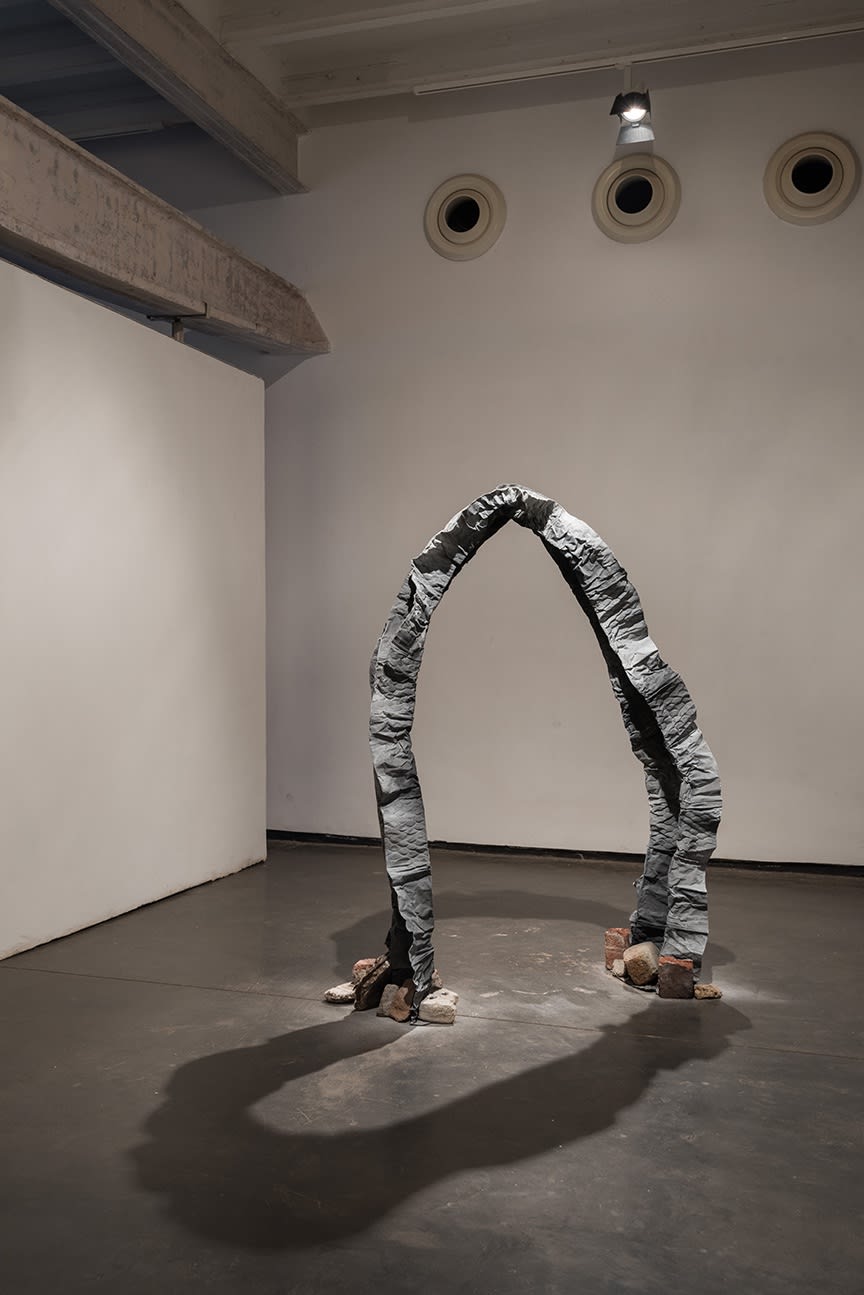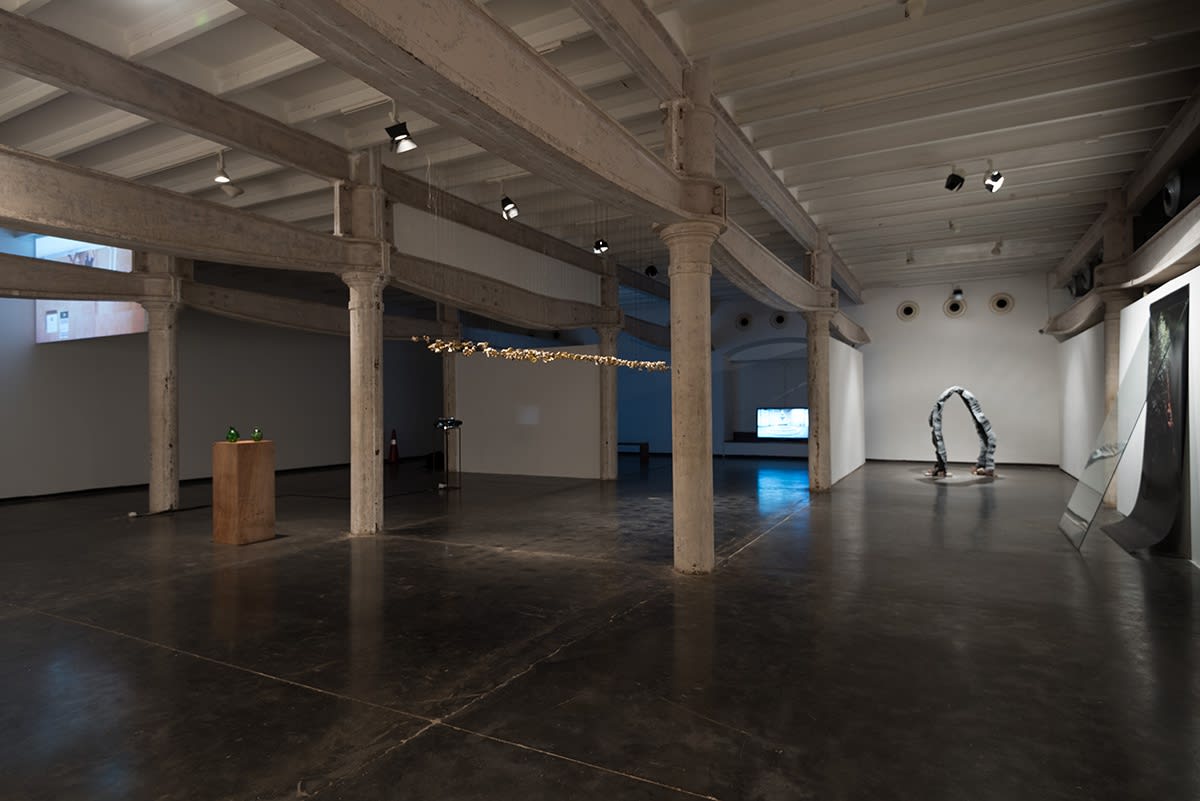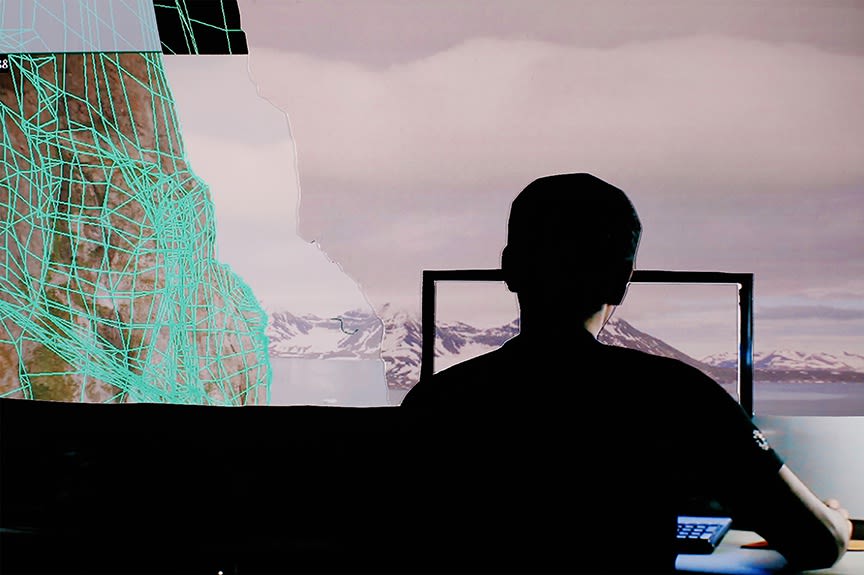
8688 is an exhibition that challenges our perception of opposites. It is only by looking as far past ourselves as possible that we can understand what makes us who we are. The exhibition turns Project 88 on its side (a conceptual gesture evoked by Shuddhabrata Sengupta of Raqs Media Collective, who by doing so, found “double infinity”), and in light of current events drives home the importance of extending hands across the divide.

Walking into the exhibition and looking directly ahead, Los Angeles based artist Sandeep Mukherjee connects memories of folds in his mother’s sarees in Pune with the ten-foot-ladder in his Los Angeles studio in a work that is both painting and sculpture, connecting the poles of his experience in a fluid serpentine form, unfolding like a saree passed across generations, and providing different vantage points and perspectives as one moves up and down the ladder, philosophically moving across territories and borders to move back to the self. The image folds and unfolds through time and space, and Mukherjee conceptualizes an image as a slice of flowing matter so that any entity or object is a slice of this movement in the universe, and the black and white colours speak to the diverse temporality between these Los Angeles and Mumbai that exist simultaneously in his (and all of our) experience. To your immediate right, Andrew Ananda Voogel, who was based for a time in Los Angeles and is now based between San Francisco and Taipei, plays further with this widespread temporality with chronograms called The Weight of Separation, Anchor and Time, and Weight and Time, inspired by stones cut from the Earth revealing 2,000 years of time. Next to these works is an installation of the remnants of Los Angeles and Bombay based artist Neha Choksi’s performance On the Other Side(2016), where she tries to communicate with an untranslatable self on the other side of the glass.
 Installation view
Installation view
Continuing on the train of thought of pushing the physical limits of the globe, Bombay based artist Shreyas Karle provides his hypotheses on gravity, trying to make sense of and break conceptually past the forces that hold the water of the world together on a “round ball of land”. This Anti-Gravity series is a beautiful precursor to works encountered at the end of the exhibition by William Forsythe and Kirsten Mosher. Seemingly defying gravity, suspended in the middle of the gallery, are 185 Japanese paper clay sculptures representing popcorn in Los Angeles based artist Pae White’s work Popstellation. These works, like many in the exhibition, are suspended and defy ideas of gravity, and the process of becoming popcorn is one of shifting states through fire. Special effects and the entertainment industry link both Bombay and Los Angeles, and moving further ahead, you encounter a video of a Sand Fountain by Berlin based artist Klaus Weber, who was also inspired by a period of time based in Los Angeles where he say the strong role of special effects on shaping the city’s views of reality. Where one would expect water coming out of a fountain, here slow moving grains of sand pour out. Could this be the land from the other side of the Earth? More on that later.
 Lucy Raven, The Deccan Trap, Video with sound, 4 minutes 19 seconds, 2016
Lucy Raven, The Deccan Trap, Video with sound, 4 minutes 19 seconds, 2016
Special effects found in Hollywood also have links to India. Passing Klaus Weber’s video, New York based artist Lucy Raven has been exploring the post-production film industry connecting Los Angeles and Mumbai and Chennai to much critical acclaim over the past few years. The scene of her 2015 film Deccan Trap opens in Chennai, taking us into the offices of International Tech Park, where Indian technicians are converting Hollywood films from 2D to 3D through a hand-done digital layering process (which is also done in offices in Mumbai). The artist hones in on the use of manual labor to create an illusion of depth both in the ancient bas-relief of Ellora as well as in the contemporary digital relief in 3D images, in addition to the idea of a “sense of relief” from one’s workload found through international outsourcing.[1]
 Installation view
Installation view
The “88” in Project 88 and 8688 connects to the idea of the uncanny connections, twinning, or even coupling between opposite sides of the Earth, an idea explored in this next section of the exhibition. Speaking to the increasing internationalization of the global image economy, Lisa Oppenheim brings the realities of war into our own horizons by juxtaposing 15 images of sunsets taken by soldiers in Iraq (found from the internet on Flikr) aligned against her sunset views at home in New York. By rotating these images on a slide projector, Oppenheim reminds us that our universes at home revolve around the same axes as those elsewhere, and in the artist’s words, the significance of the seemingly quotidian sunsets shifts with the knowledge of who captured them and where.[2] Layers of experience across disparate waters come together in Los Angeles based artist David Horvitz’s work, which melds together sea glass from Los Angeles, Mumbai, and the Aeolian island of Stromboli into sculptural vessels. These emerald coloured forms connects antipodes from the across the world through the process of blowing the glass, and the firing process and history of the glass also connect to the idea of touching the core of the Earth (the active Volcano of Stromboli is referenced in texts such as Jules Verne’s Journey to the Center of the Earth as a portal to “the other side.”) Two diptychs by 81-year-old Peruvian artist Teresa Burga entail her copying (and not tracing) the drawings of very young relatives and close friends, reversing conventional directions of learning. This process allows us to reflect how social roles are imprinted upon us, and the artist connects across the age and generation divide to forge new understanding and friendship between periods of life that are both associated with powerlessness.[3]
 William Forsythe, Antipodes 1, Installation view
William Forsythe, Antipodes 1, Installation view
Just as Oppenheim’s slides rotate, so does the planet in order to keep the gravitational pull that keeps us grounded; we are powerless against gravity. Legendary and visionary dancer and choreographer William Forsythe[4] presents a choreographic object that descends from the ceiling of the gallery and relates to Forsythe’s childhood belief that someone traveling to the South Pole risked falling off the planet, subverting the relationship between embodiment and gravity. Entitled Antipodes 1, this work is also a study into the belief in physical reality as a product of cognitive habit and not a logic based process.
 Kirsten Mosher, Soul Mate 180°, Installation view
Kirsten Mosher, Soul Mate 180°, Installation view
Back to Project 88 and the idea of it being on its side, New York based artist Kirsten Mosher connects Project 88 to its geographic antipode (the coordinates that could be found by digging through the gallery floor, through the core of the Earth, and out the other side) through a 1:1 scale video projection of a digital rendering which allows us to imagine the undulating ocean surface found there (making an uncanny twin with the rendering process found in Lucy Raven’s Deccan Trap earlier in the exhibition). 8688 launches the first chapter of Mosher’s long-term project Soul Mate 180°, exploring the idea of the Geographic Soul Mate as both an intimacy created by acknowledging distances as well as a relationship with the other side of earth not as a polarity or opposite but as a fluid, shifting continuum that extends within and beyond the planet. A common misconception is that we find land on the other side of the planet below our feet; in fact, only 15% of antipodes are land-based (or 4.4% of the Earth’s surface), our antipodes are mostly found on water. The place of the antipode might be a fixed point, but what we find there, isn’t, since water is constantly moving.
Newton’s Third Law tells us that every action has an equal and opposite reaction; the choices we make on our own Google maps coordinate have effects that can reach our antipode. In her extensive research on antipodes[5], Mosher points out that the word antipode first appeared in a translation of a Latin text as a word designating “men that have their feet against our feet”, that is, inhabitants of the opposite side of the globe with “backward feet”. The word, which originated in Greek, combines ‘anti’ -meaning “opposite” with the root pod – meaning “foot.” While we now know people on the other side of the world do not have backwards feet, it seems that we haven’t moved so far away from seeing the other as an alien that we can’t connect to. The events leading up to political tragedies of 2016 show that now, more than ever, we need to make the leaps to connect across divides, be them geographic, cultural, religious, ideological, political, to create a better place for us all to live in.
-
Diana Campbell Betancourt
-
Assistant Curators Nivriti Roddam and Abhijan Gupta



